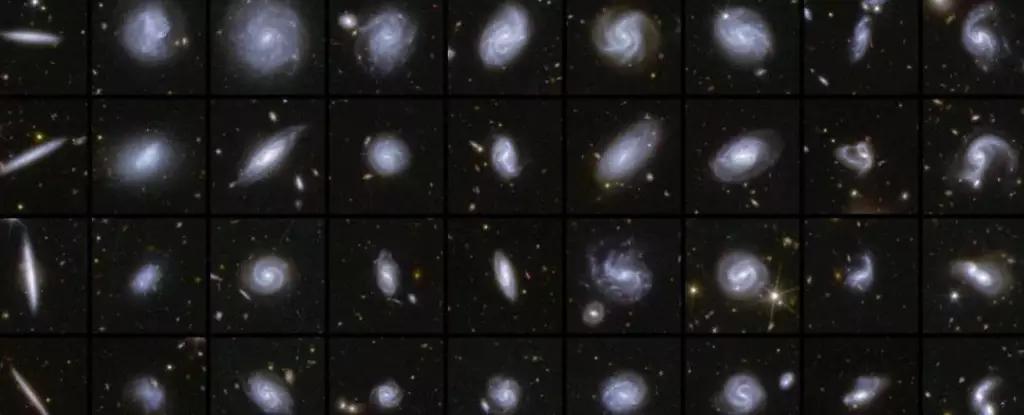Launched in July 2023, the European Space Agency’s (ESA) Euclid Space Telescope is setting a new benchmark in our quest to understand the universe. With a sophisticated 600-megapixel camera, Euclid has wowed us with breathtaking images of foundational astronomical objects, including the iconic Perseus Cluster and the ethereal Horsehead Nebula. However, these stunning aesthetics are but a prelude to the more profound ambitions of this cosmic observer, which aims to dissect the very fabric of the universe by mapping its expansion history.
The Euclid telescope’s core mission focuses on decoding the accelerated expansion of the universe and revealing the complex tapestry of dark matter and energy. It will achieve this through extensive imaging of billions of galaxies located as far as 10 billion light-years away, covering more than a third of the observable sky. The telescope’s recently released survey data includes compelling images from its first deep fields—regions of the cosmos set to be revisited and scrutinized repeatedly to gather extensive information over time.
Revolutionizing Our Understanding of Dark Matter
The concept of dark matter has intrigued scientists for decades, prompting an endless search for clues to its existence and behavior. Euclid’s deep field observations promise to revolutionize our understanding of this enigmatic substance. By repeatedly capturing images of specific regions in the sky, Euclid aims to create a detailed 3D map of the cosmos, illuminating the gravitational patterns that dark matter weaves throughout the universe.
ESA’s Director of Science, Prof. Carole Mundell, aptly describes Euclid as an “ultimate discovery machine.” Its unparalleled capacity to survey galaxies at such a grand scale reveals a universe rich in complexity, character, and interaction. The initial scan of the deep fields has already unveiled over 26 million galaxies, aiding scientists in understanding both the structure and evolution of galaxies across cosmic time.
Data-Driven Insights into Galaxy Morphologies
What sets the Euclid mission apart is its dual instrumentation approach, utilizing both a visible light camera (VIS) and a near-infrared camera (NISP). This combination is crucial for determining vital attributes of galaxies, such as their distances and masses, thereby allowing astronomers to analyze the cosmic web—it’s a web that consists of filamentary structures composed of dark matter intertwined with visible galaxies.
Clotilde Laigle, a scientist with the Euclid Consortium, points out that the current data release offers an exciting glimpse into the vast organization of galaxies. Only a fraction of the anticipated observational data has been collected, roughly 0.4% of the total galaxies that Euclid is projected to image in its mission lifespan, which is set to conclude in 2030. Once complete, the Euclid mission is expected to produce a catalogue of galaxy morphologies so expansive that it could reshape our understanding of galaxy formation and evolution.
Artificial Intelligence Meets Citizen Science
The first release of Euclid data has revealed not only galactic structures but also newly discovered gravitational lenses, transforming our grasp of this phenomenon. Notably, the identification of approximately 500 strong gravitational lenses—many of which were previously unknown—highlights the efficacy of combining technological advancements, such as artificial intelligence, with the analytical prowess of citizen scientists and established experts.
Pierre Ferruit, Euclid’s mission manager, emphasizes that this synergistic approach will harness the vast data outputs of the telescope, enabling researchers and enthusiasts alike to engage in uncovering anomalous cosmic structures. The innovative fusion of AI and human expertise empowers observers to explore the universe as never before, establishing a collaborative landscape for astronomical discoveries and analysis.
Euclid’s Legacy and Its Place in Astronomy
As Euclid charts its journey of cosmic exploration, one can draw parallels to the ESA’s Gaia mission, which has meticulously mapped our Milky Way by cataloguing over two billion stars and celestial bodies. Just as Gaia’s comprehensive datasets have become invaluable for advancing our understanding of the galaxy’s history and structure, Euclid’s profound insights into dark matter and dark energy may provide a new cornerstone for modern astronomy.
Given that dark matter and dark energy are among the most elusive phenomena in astronomical science, the wealth of data that Euclid will generate is expected to unravel many of the questions and puzzles that have perplexed scientists for centuries. Rather than seeking ultimate answers, Euclid will serve as a significant medium for inquiry, helping future generations of scientists to continue the dialogue surrounding our universe’s fundamental questions.
The impact of Euclid is already palpable, providing an intriguing glimpse into the unfathomable complexities of the cosmos. By merging technology, data analytics, and collaborative exploration, the Euclid mission stands poised to unlock the secrets of the universe, guiding humanity to a deeper understanding of our place within it.


Leave a Reply